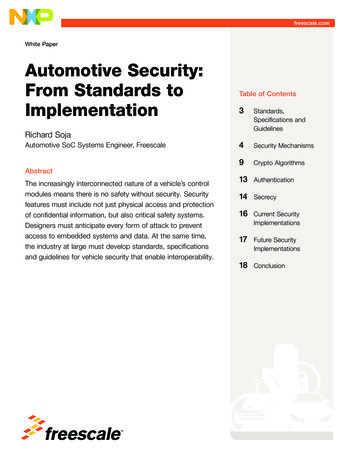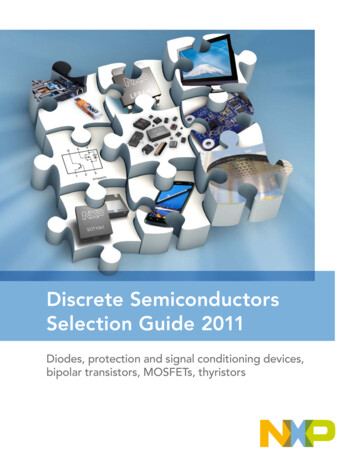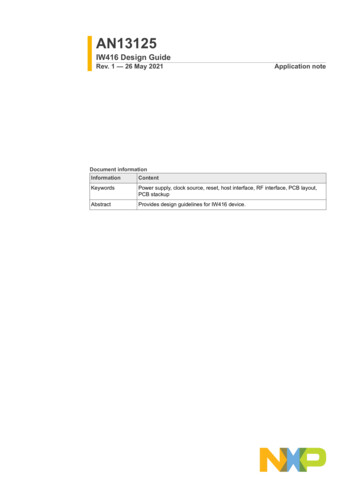
Transcription
freescale.comWhite PaperAutomotive Security:From Standards toImplementationTable of Contents3Standards,Specifications andGuidelines4Security Mechanisms9Crypto Algorithms13Authentication14Secrecy16Current SecurityImplementations17Future SecurityImplementations18ConclusionRichard SojaAutomotive SoC Systems Engineer, FreescaleAbstractThe increasingly interconnected nature of a vehicle’s controlmodules means there is no safety without security. Securityfeatures must include not just physical access and protectionof confidential information, but also critical safety systems.Designers must anticipate every form of attack to preventaccess to embedded systems and data. At the same time,the industry at large must develop standards, specificationsand guidelines for vehicle security that enable interoperability.
Automotive Security: From Standards to ImplementationIntroductionThere has been a steady increase in demand for improving the security of microcontrollersin the automotive market. When car electronics were first introduced back in the 1970s, thefunctions implemented were quite simple—they were discrete and unconnected to othercomponents in the vehicle. The component that controlled the spark plugs in the engine didnot communicate with the speedometer or tachometer in the dashboard. Long before thedays of Bluetooth cell phone controls or integrated audio systems, a trip computer might bethe most cutting-edge feature found in a new vehicle.Over time, the combination of increased electronic complexity and integration with otherfixed and portable components (e.g., keyless entry, audio systems, telematics, wirelesscommunications, etc.) has provided portals into the control systems that are deeplyembedded in the vehicle.User-accessible systems potentially contain personal and private information, while theembedded systems are inextricably tied into the fundamental physical behavior of the vehicle.These two aspects mean that if any of the vehicle control and information systems arecompromised, the opportunity for theft or damage from external entities appears.Today’s cars are also expected to hold even more private information as they become smartcards on wheels to simplify financial transactions at gas pumps, charging stations, parkinglots, toll booths and drive-through establishments. The vehicle itself will be enabled to payfees and fares, sometimes automatically.Security has come a long way since the initial introduction of simple features like car alarmsand keyless entry. In today’s vehicles, security features must include not just physical accessand protection of confidential information, but also critical safety systems such as driveby-wire braking and steering. The increasingly interconnected nature of a vehicle’s controlmodules means there is no safety without security.The nature of the automobile industry itself also introduces some additional interesting securityconsiderations. In order to support a very long and reliable operating life (which may be anorder of magnitude longer than most consumer products), the installation of counterfeit partsand control units must be prevented. The vehicle’s security systems can provide a means todo this using an authentication protocol.Another factor that can affect system reliability is the practice of “chipping” or modifying theoperating parameters stored in memory. Security features can prevent “chipping” altogetheror can detect the presence of any unauthorized modification and take action to mitigate oreliminate the effects of the modification so that the vehicle is still safe to drive, while indicatingthe need for corrective attention.Defining the architecture and implementation of secure microcontrollers requires a uniquemindset. The designer must think like a hacker and come up with bulletproof ways toanticipate and prevent access to secure data.The great range of available attack mechanisms (often referred to as the attack surface)normally means that designers must make a trade-off between the developer’s cost ofWhite Paper2freescale.com
Automotive Security: From Standards to Implementationprotecting against an attack (or a customer’s revenue lost as a result of an attack) versus thehacker’s cost of mounting the attack. For example, if it is necessary to reverse engineer thesilicon to uncover security codes, it might not make commercial sense to attempt this onsomething like a TV remote control.There is also a great deal of activity in the industry at large to develop standards,specifications and guidelines for vehicle security. Standardization allows for greaterinteroperability between the various component suppliers to the auto industry. Having setspecifications means that all manufacturers have an opportunity to develop security-awareproducts without compromise.Being able to follow published guidelines allows the manufacturer implementation freedom whileadhering to the overall architectural requirements and specifications that enable interoperability.Standards, Specifications and GuidelinesAntiquated methods of “security by obscurity” offer highly precarious and ineffectiveapproaches for protecting most modern environments. Today’s most robust forms of securityand encryption are those that survive scrutiny—in other words, security and cryptographicalgorithm specifications that themselves do not have to be kept secret but are insteaddistributed in the public domain.Within the automotive engineering community, a number of specification activities are eitherongoing or have reached sufficient maturity to be accepted as a standard. For example, theSecure Hardware Extension (SHE) specification developed by Escrypt for Audi and BMWvia the HIS Working Group, with early cooperation from Freescale in 2008, has now beenaccepted as an open and free standard.The SHE specification defines a set of functions and a programmer’s model (API) that allowsa secure zone to coexist within any electronic control unit installed in the vehicle. The securezone’s most significant features are the storage and management of security keys, plusencapsulating authentication, encryption and decryption algorithms that application codecan access through the API. These features help maximize flexibility and minimize costs.A later section of this white paper includes a description of the architecture of the SHEimplementation on Freescale’s MPC5646C single-chip microcontroller targeted at body controlapplications, where the security functions can be used for vehicle and ECU theft protectionsuch as immobilizer activation.The EVITA project, funded by the EU, has developed a set of guidelines that details thedesign, verification and prototyping of a range of security architectures for automotive ECUs.A number of companies have been active in the EVITA project, including BMW, Continental,Fujitsu, Infineon and Bosch. EVITA defines the overall functionality of three different hardwaresecurity module approaches: –full, medium and light. Moreover, it specifies an elaborateset of functions and their parameters for managing security keys as well as encryption anddecryption operations.A new European funded project called PRESERVE has emerged from the cooperating entitiesinvolved in EVITA. The aim of this new project is to develop, implement and test a scalableWhite Paper3freescale.com
Automotive Security: From Standards to Implementationsecurity subsystem for Vehicle-to-Vehicle and Vehicle-to-Infrastructure (conflated to the acronymV2X) applications. The ongoing work is expected to be completed by the end of 2014.The efforts of the PRESERVE project are targeted at demonstrating the secure transmissionof data and control information for the future Intelligent Transportation System (ITS). Thehardware security module implementation will include Elliptic Curve Cryptography (ECC),which is a form of public key cryptography.Another good example of a security standard comes from the National Institute of Standardsand Technology (NIST), which has issued the FIPS (Federal Information Processing Standards)140 standard for both software and hardware components. FIPS 140-2 defines four levels ofsecurity ranging from Level 1 with a simple single security function and no physical securityrequirements up to Level 4 that mandates physical tamper detection mechanisms andprotection against environmental attacks, such as voltage and temperature.Freescale’s P2041 devices support several encryption and authentication keys that areidentified as being Critical Security Parameters (CSPs) in the FIPS 140-2 specification. Anoverview of P2041 security capabilities is described later in this white paper.Other somewhat proprietary specifications and guidelines exist to aid the development ofsecure embedded systems. ARM developed its TrustZone security infrastructure, whichhas been integrated into microcontrollers and microprocessors from various manufacturers,including Freescale’s i.MX series and Vybrid family of devices.Another standards organization is the Trusted Computing Group (TCG), which claims to provideopen, interoperable and international standards for trusted computing. One specificationreleased by this organization is their Trusted Platform Module (TPM)—published as ISO/IEC11889 Parts 1-4. Like the SHE specification, TPM supports secure keys for authenticationand encryption functions. Developers generally implement TPM as an external peripheral witha communication bus to another microcontroller in the system. TPM specifies non-volatilememory, secret key storage, a random number generator, RSA, SHA-1, HMAC and Vernamone-time pad algorithms. The Advanced Encryption Standard (AES) is optional for TPM devices.Security MechanismsThe mechanisms needed to manage the security of an application may be implemented insoftware, hardware or a combination of both. In general, some form of software execution isalways needed. Hardware is usually provided to accelerate the execution of the cryptographicalgorithms to meet the performance requirements of the application. For example, an SHA-256algorithm used to checksum the contents of memory could easily be two orders of magnitudefaster with hardware acceleration, in comparison to a purely software-based equivalent.The benefits of hardware acceleration become even more compelling for asymmetriccryptographic algorithms such as RSA and ECC, especially as the key size increases. Figure 1shows the relative increase in computation time for software-based RSA authenticationusing a public key. With a hardware accelerator, the same public key authentication operationcan be executed in under 100 microseconds.White Paper4freescale.com
Automotive Security: From Standards to ImplementationFIGURE 1. Example of Relative Software Execution Times for Different Public Key Sizes40Execution time (ms)35302520151050050010001500Key Size (bits)20002500The partitioning between hardware and software implementations must also take in toconsideration the types of malicious attacks that must be protected against. Typically, anattack will occur because malicious software has been allowed to execute during the bootprocess or during normal run time.One approach to detect and mitigate boot code infection would be to set up a root of trustmechanism that authenticates the boot code before it executes. The authentication can beperformed by a dedicated security module implemented entirely in hardware or a combinationof hardware and software integrated in a security coprocessor. The challenge here is toguarantee that the root of trust is itself not infected with malware. One example of such amechanism is the TPM specification mentioned in a previous section.If the root of trust is based on software executing from embedded flash memory, then oneway to ensure it is indeed uninfected is to use a secure, authenticated method of flashreprogramming. This practice is already implemented by some embedded control systemsmanufacturers.Figure 2 shows an example of a flash programming protocol that relies on opening a channelbetween an external (offline) programming tool and the microcontroller. The example shownuses an RSA private/public key pair to sign and verify that the code is authentic and has notbeen modified by an attack during the programming process. In the secure offline environment,a hash is made of the software image, perhaps using SHA-256. The hash value, which uniquelyrepresents the software image, is then signed with a private key that uniquely identifies theowner of the software. The resulting signature plus software image is then transmitted to theembedded memory system, which performs its own hash on the software image.The embedded system also authenticates the signature received from the offline environmentusing the public key associated with the private key that produced the signature. Theauthentication procedure results in a hash value that must match the value from hashing thesoftware image. If they match, it means the software image has not been modified, and it wasWhite Paper5freescale.com
Automotive Security: From Standards to ImplementationFIGURE 2. Secure Flash Programming ExampleSecure Off-lineEnvironmentRun OSSWImageCompareeaturDeviceBootSW Image A)SWPublicKeyedratne hGe HasHashReferHa enceshReport ErrorSW Image Signaturereceived from the entity that used the corresponding private key. This confirms both that thesoftware is good and where it came from.This methodology does not encrypt the software that is being programmed, nor does it needto hide the signature or public key. Instead, the private key (which is stored “offline”) mustbe kept secret because it defines the identity of the provider of the software image. Theadvantage of the private/public key authentication mechanism is that only one private key isneeded and it is not embedded in the application device. Therefore, its exposure to attackscan be quite low and extensive measures can be adopted to maintain its secrecy because itis essentially kept in “offline” storage.At the same time, the single public key that matches the private key can be proliferated in allembedded devices and does not need to be hidden nor encrypted. The only provision is thata secure method must be enforced to restrict how the public key is changed, to allow for thecase where the private key has been stolen. For example, an authentication or passwordprotected protocol could be used to allow the existing key to be replaced with a new onesupplied by a certified entity. An alternative mechanism would be to revoke the existing publickey and replace it with another key from a list of preprogrammed keys or keychain.The signature could equally well be created and verified using symmetric cryptography, inwhich case the same key is used to create and verify the signature. Unlike asymmetric keys,the symmetric protocol relies on the embedded system and external entity both being able tosecretly store the same key. A successful attack on either the microcontroller or external entitywill compromise the security of the system.The SHE specification defines a protocol for securely changing secret keys. The protocoluses a symmetric AES-128 CMAC for signing and authentication and an AES-128 CBC forencrypting and decrypting the message associated with key updates. This prevents attackersfrom obtaining the key by snooping the update process. AES-128 offers the advantageof encrypting and authentication algorithms that are typically much faster than the RSAalgorithms used with public/private key pairs.White Paper6freescale.com
Automotive Security: From Standards to ImplementationFlash programming authentication determines the trustworthiness of the code image priorto placing the microcontroller in an application. Once installed in the final system, however,further measures are needed to ensure the integrity of the code (which is expected to remainunchanged) is not modified by malware (such as a Trojan) while the application is running.Checking the integrity can be done prior to running the application using a secure boottechnique that executes the integrity checker from a root of trust. This eliminates theopportunity for code to execute if it or the data image in memory appears to be corrupted.Alternatively, if no known software root of trust can be guaranteed, configuration andenablement of a run time integrity checker can be achieved solely in hardware and couldexecute prior to the application code starting. This technique also avoids the integrity processvying for memory bus bandwidth with the application process. If the resultant additional delayin start-up time is not acceptable, then another option might be to implement a run timeintegrity checker that executes in parallel with the application code, sharing memory busbandwidth with the application.The trade-offs between the two techniques are start-up time and memory bus bandwidthsharing, but there are mitigations for both these effects. Secure boot time could be shortenedby using a chain of trust strategy which splits up the memory space into multiple partitions,each of which is checked in sequence as the application software progresses through its flow.Figure 3 shows an example of this strategy.To minimize the impact that run time integrity checking has on the bandwidth loading for theapplication, some rudimentary Direct Memory Access (DMA) capability offering burst modeaccess to multi-ported system memory, plus local caching of data, can be implemented.FIGURE 3. Chain of TrustSecurity ModuleApplication CPUCheck Stage 1(App Boot)HostBoot ROMEnableCheck Stage 2(App Step 1)Stage 1(App Boot)EnableStage 2(App Step 1)Check Stage 3Another approach which may add to the security of software execution is the TrustZonearchitecture implemented on ARM-based products, such as the i.MX6 applications processor.TrustZone architecture provides partitioning of hardware that allows a single core to beoperated in either a secure or unsecure “world.” The selection of worlds is orchestrated byWhite Paper7freescale.com
Automotive Security: From Standards to Implementationsoftware called the Secure Monitor, which has the attributes of a root of trust. To switchworlds, application code must make a call to the Secure Monitor to request the switch.Memory is partitioned into secure and non-secure regions, and the non-secure world isunable to access memory that is tagged as secure. This architecture could be consideredan extension of the user/supervisor model that is implemented on a number of existingmicroprocessor architectures and has similar attributes to a hypervisor.The previous security examples assume the use of internal flash memory and that there is noexternal visibility of the flash memory bus activity. There are, however, many security applicationsthat rely on external memory—so some method of robust security must be provided forapplications that expose the transfer of data and instructions on an external memory bus.One way to achieve this is to encrypt all content that is stored in external memory, andimplement a cryptographic engine on the microprocessor, between the external bus interfaceand the CPU. Code and data fetched from external memory must now be decrypted beforebeing processed by the CPU. Likewise, data stored back to external memory must first beencrypted to prevent successful snooping attacks on the external bus.The main challenges in this architecture are how to prevent reduction in CPU performanceand how to support random access fetches from external memory. The attributes of a blockcipher operating in counter mode make it suitable for on-the-fly decryption without impactingperformance. Figure 4 shows the general architecture of such a secure system. The attributes ofa block cipher operating in counter mode are described in a later section of this white paper.FIGURE 4. Block Cipher Engine for External Memory SecurityDecryptedSW ImageSecretKeyOTPKeyDecrypt(AES)Key BlobDecrypt(AES)DeviceBootEncryptedSW ImageOther forms of software-based attacks include snooping and interfering with externalI/O communications via Controller Area Network (CAN) or other industry-standard serialports. These can also include physical attacks on the hardware, such as monitoring powerfluctuations and EMI to determine the values of cryptographic keys.White Paper8freescale.com
Automotive Security: From Standards to ImplementationIf the financial benefit to the attacker is sufficiently high, then laboratory techniques such asdecapping, electron microscopes, microprobing or noise injection using laser light may beemployed to attack a device. Protecting against these types of attacks can take the form ofphysical meshes applied to the dies themselves or adding random noise to the power profileusing on-chip logic.The level of security applied to the device must take account of the value of the assetversus the cost to the attacker. If the attack takes too long or costs too much, then thecountermeasure is sufficient.Crypto AlgorithmsCrypto(graphic) algorithms are essentially mathematical computations designed to performencryption and decryption of a message. The two main categories of algorithms aresymmetric and asymmetric.Symmetric cryptography algorithms use the same key for encryption and decryption. The keymust therefore be kept secret by all entities that use the key for secure communications. Thismay pose a problem with distributing the key to new entities, unless a method such as DiffieHellman is used, as described in the Secret Key Exchange section below.The main advantage of symmetric algorithms is their efficiency and speed of execution. Forexample, Freescale’s AES-128 hardware accelerator on the MPC5646C device can executeat the rate of 70 MB/s. In addition to enabling encryption and decryption, symmetric keys arealso used for digital signing and authentication.Encryption is often categorized as being implemented as a stream cipher or a block cipher.The main operational differences between ciphers called “stream” and those called “block” ishow the plaintext is encrypted.A stream cipher operates by combining the digits of the plain text message with a streamof random and indeterministic cipher values, known as the keystream. Figure 5 shows thebasic operation, using an exclusive-OR (XOR) operation to perform encryption of the message“HELLO” into the encrypted “DTMEY” using the randomly generated sequence of numbersshown as the keystream. The keystream’s initial value is determined by a starting seed value.FIGURE 5. Stream Cipher EncodingPlain TextHELLOCipherTextKeystream121719DTMEY22Stream ciphers are often faster than block ciphers and operate on small pieces of datatypically using bit or byte-wise XOR operations. Examples of stream ciphers include RC4,SEAL and the Vernam, or one-time pad (OTP), cipher. While stream ciphers can execute atvery high speed with simple hardware, they can be prone to security problems. The startingseed is also used to decrypt the message. To avoid security problems, the starting seed mustnever be used more than once.White Paper9freescale.com
Automotive Security: From Standards to ImplementationOne advantage of stream ciphers is that there is no dependency in encryption betweenany of the characters in the stream. This means they are relatively immune to noise in thetransmission channel because any corruption of part of the transmitted cipher text does notprevent decryption of the part that was unaffected by noise. For this reason, stream cipherssuch as RC4 are used in WEP and WPA Wi-Fi security algorithms, although WEP is nowdeprecated due to its security flaws.A block cipher operates on larger chunks of data than stream ciphers, and each blockusually incorporates values from previous blocks. This sometimes means more hardwarememory is required than for stream ciphers.Block ciphers have many operating modes, offering different trade-offs. The simplest formis Electronic Code Book (ECB) mode, which is the exception because each block of datais encrypted and decrypted independently of other blocks. This means that patterns in theplain text appear as similar patterns in the cipher text, which makes the encrypted messagesomewhat insecure. Figure 6 shows the effect of ECB encryption on an image.FIGURE 6. Visual Representation of Differences between ECB and CBCOriginalECBCBCTo overcome this insecurity, a number of industry standards have introduced alternative blockcipher modes of operation. The Cipher Block Chaining (CBC) mode uses the concept ofapplying an input variable to each block of plaintext to be encrypted. The input variable to thefirst block is a pseudo random initialization vector (IV). The input variable to subsequent blocksis the output of the preceding block, hence the chaining in the mode name. The result is thatthere is no correlation between input and output as shown graphically in Figure 6 and thusprovides superior security to ECB.Figure 7 shows the general operation of a block cipher operating in ECB and CBC mode.Both encryption and decryption involved applying the crypto algorithm to the entire plaintext.One disadvantage of this method is latency of the cipher text output.White Paper10freescale.com
Automotive Security: From Standards to ImplementationFIGURE 7. ECB and CBC Mode EncryptionECB ModeCBC ModeThere are alternative block cipher modes that eliminate this latency by operating in astreaming mode. That is, the plaintext is simply XOR’ed with a keystream, much in the sameway as the stream cipher described previously. The streaming modes of operation are OutputFeed Back (OFB), Cipher Feed Back (CFB) and Counter (CTR) modes. Their implementationdifferences lie in how their keystream is generated. Figure 8 shows the general data flow forencryption with these three modes.FIGURE 8. OFB, CFB and CTR Mode EncryptionOFB ModeCFB ModeCTR ModeThe Counter mode (CTR) is particularly interesting because its keystream is independentof the input plaintext (xi) and output ciphertext (yi), much like ECB mode. This means thekeystream can be calculated while the input data (xi) is being fetched, and encryption can beparallelized. Unlike ECB, the CTR mode has an initialization vector (IV) and counter value thatprevents patterns in the plaintext from being replicated in the ciphertext, which is the mainvulnerability of ECB. Of course, to ensure the security, all data that is encrypted with the samekey must allocate a different counter value for each block.All the aforementioned block cipher modes can be used for encryption and decryption or canadditionally be used to perform message authentication, creating a Message AuthenticationCode (or MAC, detailed in the next section). A security vulnerability exists, however, if thesame block cipher and key are used to both encrypt a message and generate its MAC.Several solutions exist for this problem: using different starting keys derived from one key,different block ciphers modes for encryption and authentication or some hybrid mode using akeyed hash function or asymmetric digital signature (described in the next sections).White Paper11freescale.com
Automotive Security: From Standards to ImplementationAnother alternative is to use a variant of the block cipher counter (CTR) mode known asGalois Counter Mode (GCM) shown in Figure 9. This algorithm can perform authentication inparallel with encryption and thus offers significant performance improvement for applicationsthat need both. Encryption is performed by the CTR mode algorithm described previously,while authentication requires a Galois field multiplier that adds complexity to hardware andsoftware implementations.FIGURE 9. GCM Mode Encryption and AuthenticationThe crypto algorithms described thus far are AES symmetric functions. The other categoryof crypto algorithms is referred to as asymmetric, where the encryption key and decryptionkey are different. The pair of keys is mathematically related and unique. One key is called the“private” key while the other is called the “public” key.The power of this type of cryptography is that the private key cannot be determined fromthe public key. Therefore, the public key generally can be distributed and stored in nonsecure storage, while only the private key must be kept secret. This potentially reduces theopportunity for attacks on data protected by asymmetric cryptography. One common use of apublic key is to encrypt data so that it can be sent securely to the owner of the correspondingprivate key. The public key cannot be used to decrypt the data, thus allowing anyone with thesame public key to securely transmit data to the same entity.Some examples of asymmetric crypto algorithms include RSA and ECC (Elliptic CurveCryptography—not to be confused with Error Correcting Codes).While asymmetric algorithms potentially provide more enhanced security than symmetricalgorithms, they do so at a cost. To achieve the same level of security, asymmetric algorithmsWhite Paper12freescale.com
Automotive Security: From Standards to Implementation(such as RSA) require larger keys than symmetric algorithms (such as AES). Moreover, thecomputational requirements for asymmetric keys are greater.For this reason, many security systems use a hybrid approach, where a symmetric secret key isdistributed using asymmetric cryptography. The symmetric key is then employed as a “sessionkey” for further secure communications using the faster symmetric algorithms provided by AES.AuthenticationCryptographic authentication is the process of verifying the identity of the sender of thedata. In an embedded application, authentication can be used to verify the source of datatransmitted on external interfaces between different control units. It can also be used toverify the trustworthiness of a software image prior to it being executed at run time, or duringdownload from an external tool prior to the image being programmed into on-chip flash.Auth
identified as being Critical Security Parameters (CSPs) in the FIPS 140-2 specification. An overview of P2041 security capabilities is described later in this white paper. Other somewhat proprietary specifications and guidelines exist to aid the development of secure embedded systems. ARM developed its TrustZone security infrastructure, which










